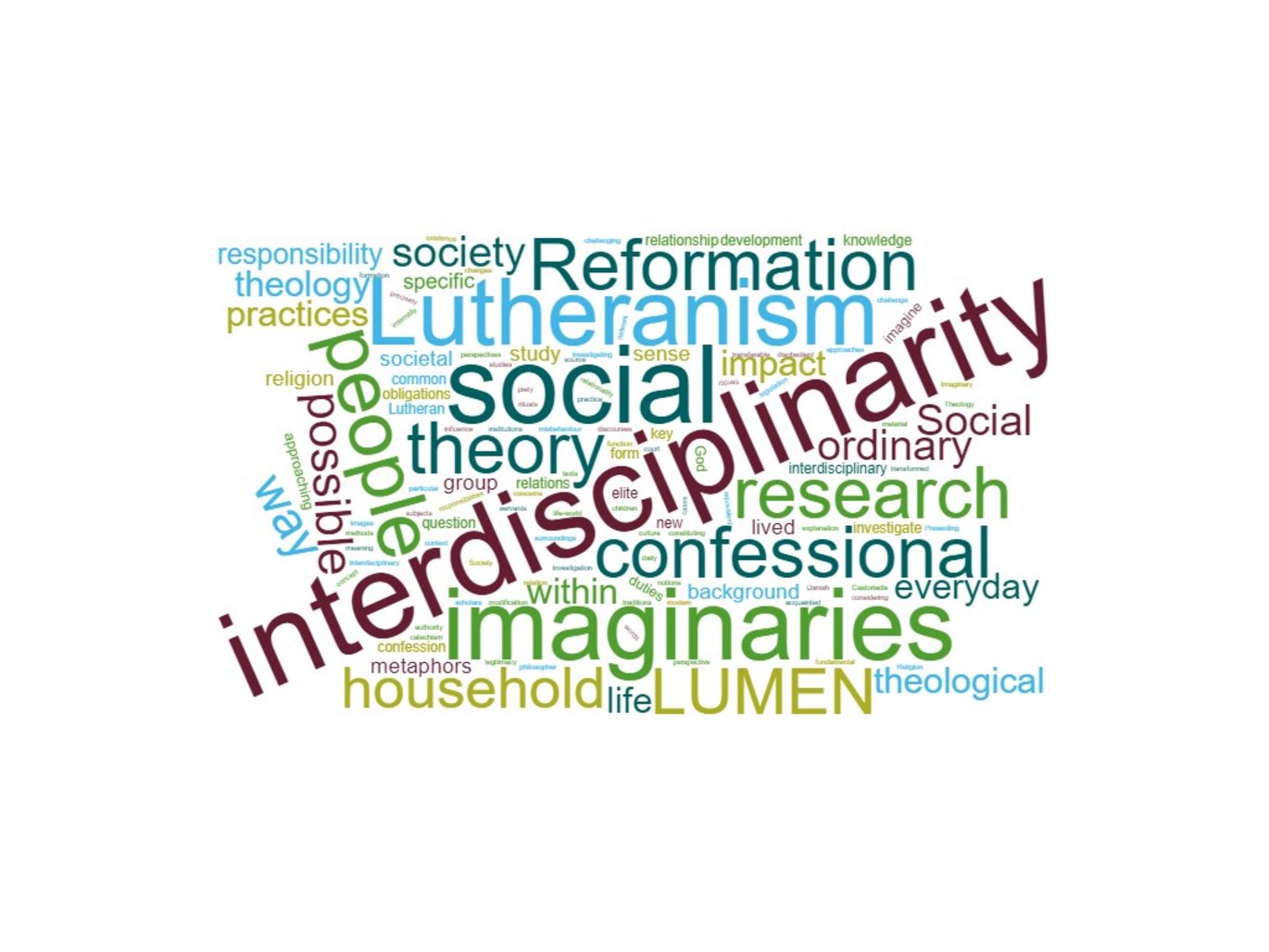"Social imaginaries" as a tool for interdisciplinary Reformation research
For some time, our research group in LUMEN has been investigating the possible impact of the Reformation upon the formation of society. The challenging aspect has been to find ways to investigate the impact that ideas (in this case religion in the form of a specific confession) have had on societal development and the everyday life of ordinary people.

“Social imaginaries” as a path to interdisciplinarity
One of the approaches we have adopted with a view to considering the impact of Lutheranism from an interdisciplinary perspective has been to employ the concept of “social imaginaries”, which was coined by Cornelius Castoriadis in his The Imaginary of Society (1975). Currently the term is most commonly known in the work of the Canadian philosopher Charles Taylor, who makes it a key word in his A Secular Age. Here Taylor defines social imaginaries as:
“…the way in which people imagine their social existence, how they fit together with others, how things go on between them and their fellows, the expectations which are normally met, and the deeper normative notions and images which underlie these expectations.” (171).
In other words, social imaginaries comprise the way in which ordinary people imagine their social surroundings, the common and shared understanding that makes everyday life and practices possible and gives a sense of legitimacy to what is going on in society. Social imaginaries are therefore not the same as social theory, although the latter can surely influence the former. Unlike social imaginaries, social theory is not something with which most people are familiar – being known only to a small group of people, an elite.
The relation between social theory and social imaginaries is two sided. Social theory transformed into social imaginaries gives meaning to concrete practices, but social theory itself is also shaped by the context of these practices. New practices can be the basis for the modification of theory and in turn for new practices, new social imaginaries.
Religion formed an essential part of the background of early modern society, with theology constituting an essential source for the historian trying to reach and understand the social theory belonging to the elite that informed the social imaginaries of ordinary people.
Social imaginaries as a way of approaching theology
Reading theology as a social theory means focusing on questions like: How is the relationship between human beings and God perceived? How is the relationship between human beings presented internally? In Lutheran theology in particular, where relationality plays a fundamental role, it becomes clear that social metaphors play a dominant role in the explanation of key theological issues. Presenting such theologically inherent social metaphors makes it possible for scholars not acquainted with the depth of theological discourses to step into theological texts and understand precisely the points that make sense when looking for the possible impact of specific theological traditions upon concrete societal changes. Theology, then, both plays the role of an equivalent to social theory, and entails imaginaries, often in the form of social metaphors, that are transferable to the “life-world” of common people, even if their knowledge does not surpass or even come close to approaching catechism level.
“Social imaginaries” in everyday life
One central challenge in the study of how much impact Lutheranism had on Danish society concerns not only legislation and institutions, but also people’s everyday life and (for instance) their understanding of obligations and duties within society. With the deeper understanding of the social theory embedded in the Lutheran confession provided by theology, and a sense of the social imaginaries made possible against this background, it is possible to investigate the social imaginaries of ordinary people.
One of our studies focuses on the household, especially authority and social responsibility within the household. The study of court cases involving disobedient children or servants, or married people who misbehave in some way, makes it possible to trace expectations regarding the social relations of the household, as well as people’s understanding of their own role within the household, their own duties and obligations, and those of others. These expectations are based on social imaginaries of the household and its network of social relations and responsibilities, which help the household – and society – to function in practice.
The central issue in our investigation is the extent to which the social imaginaries of ordinary people who have to explain misbehaviour in the household draw on social imaginaries which are specific to the confessional. This question can only be answered based on both extended theological knowledge and historical background and methods.
Other points about “social imaginaries” and lived religion
The question of which social imaginaries can be traced in the everyday life of ordinary people and how they influenced societal development is studied from the perspectives of other subjects within our group as well. One object of study is the way lived religion reveals social imaginaries in the way that rituals are performed, and in the way that daily piety is conducted. Another is social imaginaries displaced in material culture, especially within the household, revealing how people “lived with God”.
Cornelius Castoriadis. L’insitution imaginarie de la sociêté. Paris: Éditions di Seuil, 1975.
Charles Taylor. A Secular Age. Cambridge, Mass/London: The Belknap Press of Harvard University Press, 2007.
Bo Kristian Holm & Nina Javette Koefoed. Lutheran Theology and the Shaping of Society. The Danish Monarchy as Example. R5AS 33. Göttingen: Vandenhoeck & Ruprecht, 2018.
